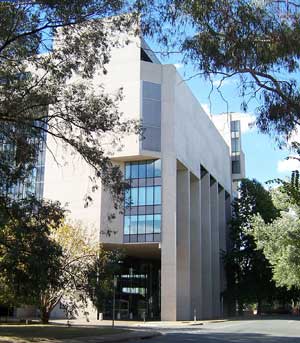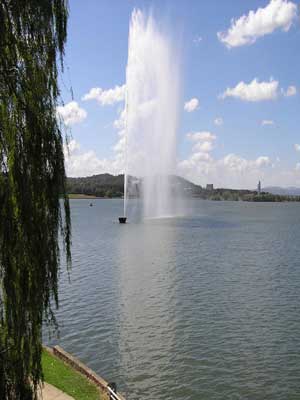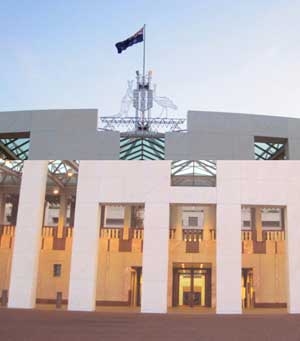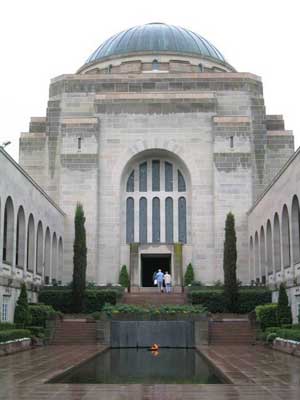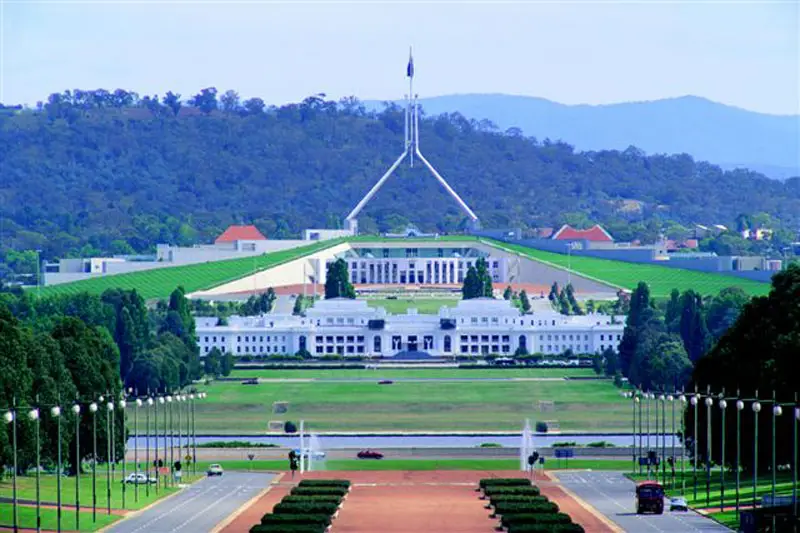
Australian Capital Territory
The Australian Capital Territory (ACT) is a territory of the Commonwealth of Australia, and is the site of Canberra, Australia’s capital city. The ACT is wholly surrounded by the state of New South Wales. The ACT has internal self-government, but it does not have the legislative independence of the Australian states. It is governed by a Ministry headed by a Chief Minister. Laws are made in a 17-member Legislative Assembly that has all state and local government functions. However, its decisions can be overruled by the Australian Government.
Unlike other self-governing Australian territories (eg Norfolk Island, Christmas Island and Cocos (Keeling) Islands), the ACT does not have an Administrator. The role of the Crown in the government of the ACT is played by the Governor-General of Australia. In Australia’s Federal Parliament, the ACT is represented by four members (two Senators, and two members of the House of Representatives).
Canberra is Australia’s capital city and largest inland city (population 322,000). It is located at the northern end of the Australian Capital Territory (ACT; population 339,000). Canberra is the 8th most populous city in the country; it is smaller than any of the state capitals except Hobart.
Most Australians pronounce the city’s name “CAN-bruh”. A minority pronounce it “CAN-buh-ruh” and a few use “can-BEAR-uh”, though the latter is generally considered incorrect. The varying pronunciation is to some extent a class-based difference.
The word Canberra is said to mean “meeting place” in the Ngunnawal language, though some accounts say that it means “women’s breasts”, a reference to Mt Ainslie and Black Mountain, two landmarks in the central Canberra area. The name was apparently used either in relation to the Molonglo River which, along with the Murrumbidgee River, flows through Canberra or as reference to corroborees held during the seasonal migration of the Ngunawal people to feast on the Bogong Moths that pass through the region each spring. However, the first recorded name for the locality was Canberry or Canbury (both versions are recorded in early church registers), a name also found in England and other ex-British colonies. As with other capital cities, the word Canberra is also used to refer to Australia’s federal government and especially the Australian Federal Parliament.
Canberra has many national monuments and institutions such as Government House (the official residence of the Governor-General), Parliament House, the High Court of Australia, the Australian War Memorial, the National Gallery of Australia, Telstra Tower, the Royal Australian Mint, the National Library of Australia, and the National Museum of Australia.
Canberra has a number of sister cities, including Nara in Japan and Versailles in France. Canberra also has a friendship agreement with Dili, capital of East Timor.
Before European settlement the area now known as the ACT was inhabited by three Aboriginal tribes: the Ngunnawal, Walgalu, and Ngarigo. White exploration and settlement did not occur until the 1820s. From 1824 onwards, settlements and homesteads, and ultimately some small townships such as Hall and Tharwa, were established in the area. One homestead of special historical interest was Lambrigg, near Tharwa. This was the place in which William Farrer developed the rust-resistant Federation wheat strain that had a major beneficial effect on Australia’s wheat industry. Farrer died at Lambrigg in 1906.
When the constitution for the Commonwealth of Australia was being negotiated between the colonies, Melbourne and Sydney each wanted to become the capital. As a compromise, it was agreed that the capital would initially be Melbourne, until a new capital city could be built. When finally agreed, the Constitution specified that the new capital city would be located in territory taken from New South Wales, but be at least 100 statute miles from Sydney. The present site was chosen in 1908, with additional territory at Jervis Bay (now a naval base on the NSW coast) allocated so the national capital could have a sea port. In 1910 the Australian Capital Territory was ceded by act of Federal Parliament in Melbourne. The politician King O’Malley responsible for the legislation creating the ACT, also passed a law later that year making the ACT an alcohol-free area. In 1911 an international design competition was held, which was won by Walter Burley Griffin. The official naming of Canberra and its official construction began on 12th March, 1913.
The Federal Government officially moved to the ACT from Melbourne on the formal opening of the Provisional Parliament House on 9th May 1927. Among the new parliament’s first acts was the repealing of the prohibition laws. At first the public service continued to be based in Melbourne, but the various departments were gradually moved to Canberra over the years. The territory was initially known as the Federal Capital Territory (FCT). In 1938, the territory was formally named the Australian Capital Territory. It gained self-government in 1988.
Canberra’s residents live in a planned city originally designed by Walter Burley Griffin, although the Burley Griffin design has now been altered significantly, notably by changing the location of Parliament House from the lakeside site Burley Griffin envisaged. The city is laid out on two major perpendicular axes, a water axis that stretches along Lake Burley Griffin, and a ceremonial land axis stretching from Parliament House on Capital Hill northeastward to the Australian War Memorial at the foot of Mt Ainslie. The area known as the Parliamentary Triangle is formed by three of Burley Griffin’s axes, stretching from Capital Hill along Commonwealth Avenue to the Civic Centre around City Hill, along Constitution Avenue to the Defence precinct on Russell Hill, and along Kings Avenue back to Capital Hill. Many significant public buildings, such as the National Library and the High Court are located within this triangle.
Canberra is divided into seven districts. In order of development, they are: North Canberra, South Canberra, Woden, Belconnen, Weston Creek, Tuggeranong, and Gungahlin. The first two are based on Walter Burley Griffin’s designs. The others all have a land contour design and a central shopping area known as a Town Centre. The districts are generally separated from each other by bushland reserves, many of which have wildlife such as kangaroos and kookaburras.
The suburbs contained in these districts are generally named after famous Australians. Some are named after early settlers or Aboriginal terms. Street names within each suburb generally follow a particular theme. For instance, the streets of Duffy are named after Australian dams and weirs, Page’s streets are named after biologists and naturalists, and the streets of Gowrie are named after Australian Victoria Cross recipients.
There are also three suburbs that are considered to be industrial districts: Fyshwick, Mitchell and Hume. Streets in these areas also follow a theme – for instance, the streets of Fyshwick are named after Australian industrial towns. In addition, there is Oaks Estate, a small suburb located near the ACT/NSW border which is not part of any of the above districts and which has close ties with the neighbouring NSW town of Queanbeyan. Many of its residents feel a greater affinity with Queanbeyan than with the ACT. On the other hand, Jerrabomberra is officially part of Queanbeyan but many of its residents work in the ACT and consider themselves essentially part of Canberra.
As well as the unusual road system featuring many circular streets and roundabouts, Canberra’s highly planned nature has led to a striking absence of commerce on its major trafficked streets. There is also relatively quick access and minimal traffic congestion along Canberra’s roadways, but the layout of many roads in circles can be confusing to visitors and studying a map prior to travelling from one part of Canberra to another is recommended for drivers unfamiliar with the city. Unlike most other capital cities in Australia, they have been designed with motor vehicle traffic in mind.
Canberra is located near a portion of the Brindabella Ranges, approximately 150 km inland from Australia’s east coast. It is located at altitudes that range from 550m to 700m above sea level. This results in temperature ranges from -5° C to 35° C. The hottest days are generally in December and January. In wintertime, the days can get very chilly, and snow falls every few years.
The soil in Canberra is reasonably fertile, but is more suited to grazing than cultivation. There are also some limestone plains and caves in the region. The Molonglo River flows through Canberra, as does the Murrumbidgee now that the city has extended to the south in Tuggeranong. At its western end, the Molonglo has been dammed to form the body of water in the centre of the city called Lake Burley Griffin. The Molonglo flows into the Murrumbidgee at a point northwest of Canberra, which in turn flows along Canberra’s southwestern outskirts. The Queanbeyan River joins the Molonglo River at Oaks Estate just within the ACT’s borders. A number of creeks that flow off from the Molonglo and Murrumbidgee, such as Jerrabomberra and Yarralumla Creeks, also exist in the Canberra area. Two of these creeks, Ginninderra and Tuggeranong Creeks, have likewise been dammed to form Lake Ginninderra and Lake Tuggeranong.
The area had a history of sometimes lethal floods until recent times, and prior to its formation, Lake Burley Griffin area was a flood plain. A wetlands, known as the Jerrabomberra Wetlands, lies directly east of South Canberra. This is now a nature reserve area. Numerous large hills, such as Mt Ainslie, Mt Mugga Mugga, Mt Taylor and Black Mountain dot the Canberra area, but have been left unsettled. This does mean a colder existence for Canberra’s residents as, in winter, cold air pours down from these peaks to form pockets of cold air in the inhabited valleys. At wintertime, snow sometimes falls on these hills, and always along the heights of the Brindabella ranges.
Canberra has four distinct seasons, unlike many other Australian cities whose climates are moderated by the sea (it is Australia’s only inland capital city). Spring (September-November) is typified by cool days, lengthening sunlight, and periodic rain. The Canberra Spring is signalled by buds and blossoms on fruit trees, flower festivals, the return of Bogong Moths from their annual migration, and the annual Floriade flower festival. Daylight saving commences on the last weekend of October, along with the first planting of most garden crops. Plants like tomatoes, are kept inside until early November to avoid frosts.
In Summer, rain ceases before Christmas and humidity is generally low until March (or even April.) The light is stark, and hats are worn outside to protect from the sun. Air conditioned shopping malls are used as havens from the heat. Bush fires are a constant threat. Fruit trees make some weeks hectic while jam is made. In practice, summer ends for Canberrans after the Canberra Day festivities in mid March.
Autumn brings freshening days and ANZAC Day (25th April) can be quite sharply cold for those attending the dawn service at the Australian War Memorial. The leaves of the many deciduous trees such as poplars, oaks and elms turn and fall, producing a colourful spectacle each May. Rain begins again at odd intervals.
Winter is typically the season of rain, but in 2003 and 2004 drought has persisted. The end of the financial year on 30th June is celebrated in government and business offices. Fog frequently occurs during winter mornings, and can cause flight delays or cancellations at Canberra International Airport. Canberrans know to wear layers of clothing that can be taken off in heated offices and shopping malls. However, on days with still air and clear skies, Canberrans can wear a T-shirt even with air temperatures under 10 degrees Celsius.
The surrounding bushland and the original bushland that Canberra was built in is a mix of eucalyptus savannah, scrubland, swamplands and dry eucalyptus forests. The grazing properties and farms that were here before the city saw the clearing of much of the native forest, still found in the unsettled areas that comprise most of the Australian Capital Territory.
Canberra is approximately 3 hours by road from Sydney on the Hume Highway (National Highway 23) and Federal Highway, 7 hours by road from Melbourne on the Hume Highway and Barton Highway (National Highway 25), and 2 hours on the Monaro Highway (National Highway 23) to the snow ski fields of the Snowy Mountains and the (Mount) Kosciuszko National Park.
Canberra International Airport has a full schedule of domestic services to several state capitals. There are long-term plans to introduce regular scheduled international flights, but to date the only international flights have been those carrying heads of state such as the US President, and charter flights. In July 2004 international flights to Fiji commenced but were abandoned after two months. There is a rail service between Canberra and Sydney that takes about four hours. This service is operated by CountryLink. Plans to have a very fast train, with a travel time of about 81 minutes, operate between Canberra and Sydney have been contemplated, but not implemented. A tilt train was trialled on the line but was not successful. A large number of inter-state bus companies provide services to and from Canberra.
Canberra is serviced by a bus-based public transport system, called ACTION, short for Australian Capital Territory Internal Omnibus Network, as the city has no railway system other than an interstate railway that terminates in the suburb of Kingston. The ACTION bus service provides comprehensive services for Canberra residents.
There have been government proposals that tramways or a light-rail system be added to Canberra, either a tourist-based one that would link many of Canberra’s tourist attractions, or one that links the new and developing district of Gungahlin with the City Centre. As of 2004, nothing has come of these plans. A private bus service also operates between Queanbeyan and Canberra.
The Australian Capital Territory has no other settlements larger than a village outside the city of Canberra. As such, the traditional roles of both a City Council and State Government are performed by the one entity, the ACT Legislative Assembly. The Assembly building is located at Civic Square. Outside is a statue Ethos (Tom Bass, 1961, and erected there in 1962) representing “the spirit of the community”.
From 2004, Assembly members are elected on fixed four year terms by the ACT’s population using a proportional voting system (from 1989 to 2004 members were elected on three year terms). There are 17 members, who represent three different multi-member electorates. Seven of these represent the seat of Molonglo, and there are five each from Gininderra and Brindabella. Government is through the use of ministries along a State rather than local government model.
Up until the 2004 ACT election, ACT governments have always been minority ones, ie. they have never won more than half of the assembly’s 17 seats. This has led to some unusual alliances. In one instance, two parties with conflicting political views allied to form government. More recently, an ACT Liberal Party government ruled the ACT with the help of an independent member who was given an ACT ministry in return for his support. At the 2004 ACT election the ALP headed by incumbent Chief Minister Jon Stanhope won nine of the seventeen seats and formed the first ACT majority government. The Federal Government retains some influence over the ACT’s government. Under the provisions of s122 of the Commonwealth Constitution, the Federal government can overrule any law of an Australian territory of which it disapproves. This power is seldom used. No ACT election can be called except with the Federal Government’s approval. Also, a Commonwealth organisation, the National Capital Authority, can veto and influence decisions involving Canberra’s urban development and growth.
The Australian Federal Police (AFP) carry out all police services normally provided by a state police force. The AFP operate under a unique contractual agreement with the Australian Capital Territory Government to provide Policing and Crime Prevention services to the ACT community. Persons arrested on an offence are tried either in the ACT Magistrate’s Court or, depending on the severity of the allegation, the ACT Supreme court. However, persons sentenced to imprisonment are sent to a NSW jail as there are no prisons in Canberra. Various proposals to establish a prison within Canberra have been mooted over the years, but while these have led to heated public debate, none has so far been implemented.
Courts such as a Small Claims Tribunal and a Family Court exist for civil law actions and other non-criminal legal matters.
Although only a minority of the Canberra workforce is now directly employed by government, the city’s main industry is still government and public service. It contains the Federal Parliament and the headquarters of most government departments (for instance, Defence, Foreign Affairs and Trade, and the Treasury).
A number of military establishments of the Australian Defence Force exist in or near Canberra, most notably RAAF Fairbairn (now effectively closed as a base for the Royal Australian Air Force, except for housing the VIP Flight) and HMAS Harman, which contrary to what its name suggests, is not a ship (becoming a tri-service multiuser depot). Military colleges also exist.
Canberra’s second largest (and most noticeable) industry is tourism, with a large number of Australian and international visitors coming to the city each year. The most popular times are spring and autumn, with the annual Floriade spring flower display (held each year in September/October) being the biggest. Other popular and noteworthy tourist spots in Canberra include the Parliamentary triangle (and in particular both the New Parliament House and the Old Parliament House), monuments such as the Australian War Memorial, and working national institutions like the Royal Australian Mint. Canberra also has the High Court of Australia, which is the final court of appeal for lawsuits within Australia and which can make rulings on the Australian Constitution.
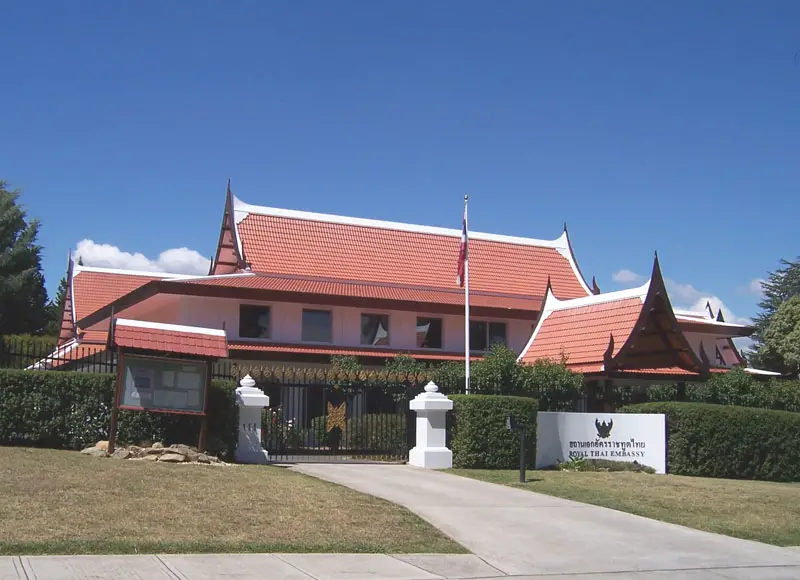
Canberra is home to most foreign embassies and high commissions, the majority of which are located in the suburbs of Yarralumla, Deakin and O’Malley. The Yarralumla embassy area is another tourist attraction, as the embassies in that suburb are generally built in the style of their home country.
Over the years, many embassies have been the focal points of public demonstrations and protests. For instance, the French Embassy received attention from demonstrators during the French nuclear tests in the Pacific, whilst the Indonesian Embassy was the subject of demonstrations in relation to East Timor. Some protests have been violent, eg. the embassy of the then Soviet Union came under attack in 1969 and 1971. In 2004, a man was convicted for his involvement in an al-Qaeda plot to bomb the Israeli Embassy.
There is also the Aboriginal Tent Embassy, first set up on 27th January 1972, and located outside Old Parliament House. This consists of tents and a series of spears and ceremonial fires. In spite of its name, it is not a diplomatic mission, but rather exists to draw attention to indigenous rights and land issues. Its existence and some of the actions of its occupants have been the subject of some controversy, but its presence is tolerated by the Canberra authorities. In September 2004, it was subject to an arson attack.
As Australia’s political centre, Canberra is naturally the home of much of Australia’s political reportage and thus all the major media organizations, including the commercial television networks, the Australian Broadcasting Corporation, and the metropolitan newspapers maintain bureaus there. Many are represented in the “press gallery”, the group of media people that follows the national parliament.
The National Press Club is on National Circuit, in the South Canberra suburb of Barton, and it regularly broadcasts its weekly lunches, in which a guest gives a half-hour speech and then goes through a half-hour question session afterwards. This has been a popular means by politicians to give speeches and announce policies, but other guests have included movie and TV celebrities.Canberra has its own daily newspaper, the Canberra Times which was established in 1926.
Canberra has five television stations, two government funded (ABC and SBS) and three commercial (Prime, WIN and Southern Cross Ten). Community Radio 2XX FM is Canberra’s primary source of multicultural radio broadcast, featuring weekly programmes in twenty languages, in addition to community service and specialty music programmes. There are a number of other commercial AM and FM radio stations.
Canberra is the home of the Australian National University, based in Acton, and the University of Canberra, based near Belconnen. The Australian Defence Force Academy (or ADFA) and the Royal Military College, Duntroon (or RMC) are near the suburb of Campbell, in Canberra’s inner northeast. ADFA teaches military undergraduates and postgraduates and is officially a campus of the University of New South Wales; Duntroon provides Australian Army Officer training. Two religious campuses are sited in Canberra: Signadou in the North Canberra suburb of Watson is a campus of the Australian Catholic University; St Mark’s Theological College adjacent to the Parliament House is a campus of Charles Sturt University. The multicampus Canberra Institute of Technology also operates in Canberra.
Canberra has a full range of sporting facilities. Perhaps the two most significant are Canberra Stadium (formerly known as Bruce Stadium) and the Australian Institute of Sport, a quasi-educational body that trains many of Australia’s Olympic athletes. Canberra also possesses numerous sporting ovals, golf courses, tennis courts and swimming pools that are available for use by the public. A Canberra-wide series of bicycle paths are available to cyclists for recreational and sporting purposes. The nature reserves around Canberra have a large range of walking paths. It has several national sporting teams, the Canberra Raiders (Rugby League) and the Brumbies (Rugby Union) being the most prominent. An annual sporting event of historical interest is the “Prime Minister’s XI” cricket match, normally played at Manuka Oval in South Canberra.







